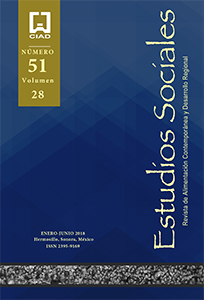La satisfacción del comensal como elemento clave del binomio gastronomía-turismo en Tijuana
The satisfaction of the consumer as a key element of the gastronomy-tourism binomial in Tijuana
Abstract
With the growing interest in gastronomy, as a value for tourism destinations, the issue of satisfied customers becomes paramount. Therefore, in this paper, the diners of the two most important gastronomic areas in Tijuana (downtown and Gastronomic District), Mexico were surveyed. The objective, besides briefly characterizing both places, was to measure the degree of consumer´s satisfaction, as well as to identify the specific factors that determine it. Methodology: For the analysis, the non-participant observation technique and a structural equations model (PLS) with five constructs and 13 observed variables were proposed. It also further investigates the importance-performance matrix analysis (IPMA). Results: Results show satisfied customers for both zones with an opportunity of improving the quality of service in the Center area and the perception of the area in the Gastronomic District. Limitations: The main limitation is the lack of inclusion of the construct expectations in the model. Conclusions: From the results, we concluded that the client, in both areas, is satisfied, detecting an opportunity of improving the quality of service in the Center area and the perception of the area in the Gastronomic District.Keywords:
Contemporary food, gastronomy, satisfaction, Tijuana, valuation, structural equations.Abstract
With the growing interest in gastronomy, as a value for tourism destinations, the issue of satisfied customers becomes paramount. Therefore, in this paper, the diners of the two most important gastronomic areas in Tijuana (downtown and Gastronomic District), Mexico were surveyed. The objective, besides briefly characterizing both places, was to measure the degree of consumer´s satisfaction, as well as to identify the specific factors that determine it. Methodology: For the analysis, the non-participant observation technique and a structural equations model (PLS) with five constructs and 13 observed variables were proposed. It also further investigates the importance-performance matrix analysis (IPMA). Results: Results show satisfied customers for both zones with an opportunity of improving the quality of service in the Center area and the perception of the area in the Gastronomic District. Limitations: The main limitation is the lack of inclusion of the construct expectations in the model. Conclusions: From the results, we concluded that the client, in both areas, is satisfied, detecting an opportunity of improving the quality of service in the Center area and the perception of the area in the Gastronomic District.Keywords:
Contemporary food, gastronomy, satisfaction, Tijuana, valuation, structural equations.Downloads
Published
How to Cite
Issue
Section
Para que sean publicados artículos, ensayos y reseñas críticas en Estudios Sociales, la revista debe contar con la aceptación de parte de los autores/autoras de las condiciones siguientes:
1. Los autores conservan los derechos de autor y ceden a la revista el derecho de la primera publicación del trabajo registrado bajo la licencia de Creative Commons Reconocimiento-NoComercial (CC-By-NC) que permite a terceros utilizar lo publicado, siempre y cuando mencionen la autoría del trabajo y a la primera publicación en esta revista.
2. Los autores pueden realizar otros acuerdos contractuales independientes y adicionales para la distribución no exclusiva de la versión del artículo publicado en esta revista (por ejemplo: incluirlo en un repositorio institucional o publicarlo en un libro) siempre y cuando indiquen, claramente, que el trabajo se publicó por primera vez en esta revista.




















